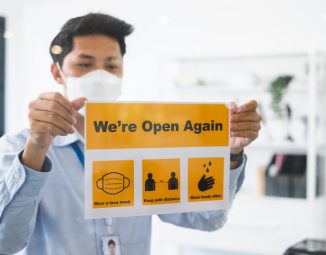Families First Coronavirus Response Act (“FFCRA”): Fast Facts
On Wednesday, March 18, 2020, President Trump signed the Families First Coronavirus Response Act (H.R. 6201) into law. The law, which is part of a series of anticipated bills to deal with the COVID-19 pandemic, includes two (2) employment-related provisions that companies and employees should be aware of: (1) an expansion of the Family and Medical Leave Act (“FMLA”); (2) emergency paid sick leave; and (3) additional unemployment funding.
Who is Covered?
All companies with fewer than 500 employees will be covered under the Emergency FMLA and Paid Sick Leave portions of the FFCRA. While the law does not have a hard and fast exemption for small businesses, it grants the U.S. Department of Labor (“DOL”) the authority to issue regulations exempting certain health care providers and emergency responders, and to exempt small businesses with fifty (50) or fewer employees “when the imposition of such requirements would jeopardize the viability of the business as a going concern.” These regulations have not been promulgated yet, but should be forthcoming.
When Will the Law go Into Effect?
The law will take effect on April 2, 2020 and its provisions will expire automatically on December 31, 2020.
The Employment Provisions
1. FMLA Expansion
The FMLA currently provides for up to twelve (12) weeks of unpaid job-protected leave that qualifying employees may use for their own serious medical condition, to care for family members, or for certain qualifying events such as military call-ups. The FFCRA expands eligibility for FMLA leave to employees who are unable to work due to a need to care for a child under the age of eighteen (18), if their child’s school or child care provider has been closed or due to COVID-19.
Under the FFCRA, the first ten (10) days of such leave will remain unpaid. Employees are permitted to utilize any accrued PTO they may have in order to be paid during these first ten (10) days, however, they are under no obligation to do so. However, after the first ten (10) days, covered employers must provide paid leave at the rate of at least 66% of the qualifying employee’s regular pay rate. Paid leave is capped at $200 per day, and there is an aggregate cap of $10,000 per employee (the equivalent of ten (10) weeks of paid leave at the maximum amount).
Notably, an earlier version of the law provided for paid leave for an employee’s own illness. However, that language was removed before the bill was approved by the Senate and signed into law.
2. Emergency Paid Sick Leave
The FFCRA also provides for up to ten (10) days of temporary emergency paid sick leave. This leave is available in six (6) scenarios:
- Employees who are subject to a government mandated isolation/quarantine;
- Employees who have been advised by a healthcare provider to self-quarantine;
- Employees who have COVID-19 symptoms and are seeking treatment for it;
- Employees caring for an individual who is either subject to a government mandated quarantine or was advised by a healthcare provider to self-quarantine;
- Employees caring for their children at home as a result of their child’s school closing; and
- Employees experiencing any other substantially similar condition as certified by the Department of Health and Human Services (“HHS”).
Scenarios 1-3 (above) allow an employee to collect a maximum paid sick leave per day of up to $511 (an aggregate of $5,110 over two (2) weeks). Scenarios 4-6 (above) allow an employee to collect a maximum paid sick leave per day of $200 per day (with a max cap of $2,000 in the aggregate over two (2) weeks). For the purposes of the new law, it is irrelevant for how long an employee has been employed by the company—employees will immediately become eligible for paid sick leave if they fall within one of the categories above.
Full-time workers will be eligible for up to eighty (80) hours of paid sick leave, while part-time employees’ eligibility is calculated by averaging the number of hours that part-time employee works regularly over a two (2) week period. This leave will not carry over into 2021.
The law also states that employers may not require employees to use other paid leave provided by the employer before the employee utilizes this paid sick time. In the absence of clarifying regulations stating otherwise, it appears that employers who already provide paid sick leave or all-purpose paid time off (PTO), either voluntarily or to comply with state or local paid sick leave requirements, will need to provide additional paid leave on top of existing policies.
The law also provides for a tax credit to employers who provide qualifying paid leave to employees to be applied against the employers’ portion of FICA taxes. The tax credit is generally equal to 100% of the qualifying paid leave provided to the employees each quarter. If the tax credit exceeds the employers’ portion of FICA taxes due, the excess amount will be treated as an overpayment and will be refunded to the employers. In addition, the qualifying paid leave provided to employees are not considered wages and therefore, no federal employment taxes will be collected on such amounts from either the employers or the employees. Even though the FFCRA provides for generous tax credits and exemptions from certain taxes, employers remain responsible for paying the up-front costs of these new benefits.
3. Additional Unemployment Funding
The FFCRA does not mandate that employers provide any pay or benefits to employees who are furloughed or laid off due to closures or business downturn caused by COVID-19. However, the law provides approximately $1 billion in grants to state governments to help cover the cost of providing unemployment benefits.
Notice and Retaliation Requirements
Employers will be required to post a conspicuous notice provided by the DOL in their workplace (and potentially virtually, if the physical location is closed) alerting their employees of these new provisions.
Lastly, the FFCRA provides that it is be illegal to discipline or discharge an employee for taking paid sick leave, or for filing a complaint for non-compliance.
Our Takeaways
The FFCRA is an important new part of the various federal, state, and local laws that will impact employers as the U.S. continues to grapple with the COVID-19 pandemic. Virtually all employers will be impacted by this pandemic, and will be faced with legal, business, and financial challenges. HR Legalist will continue to monitor legal developments as they continue to change, sometimes at quite a rapid pace.
Readers with questions are encouraged to contact one of Obermayer’s labor and employment attorneys, or the firm’s COVID-19 Legal Response Team, – a designated group of Obermayer attorneys ready to respond to clients’ needs in numerous legal areas as they relate to the COVID-19 pandemic. Our attorneys continue to work remotely in order to respond to client needs, and we recently hosted a webinar on the employment law implications of COVID-19 (a recording of which is available here). We at Obermayer stand ready to assist you in navigating these unchartered waters.
Finally, we urge you to keep doing your part to help minimize the impact of the novel coronavirus through social distancing and other best practices. We hope that all of our readers stay safe and healthy during this uniquely challenging time.
The information contained in this publication should not be construed as legal or medical advice, is not a substitute for legal counsel or medical consultation, and should not be relied on as such.





